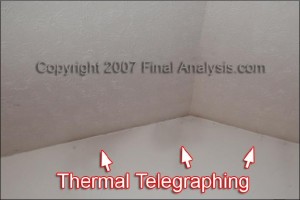“Ghosting” is a term used to describe the dark streaks that sometimes develop on walls and ceilings (especially along joist or stud lines), around doorways, at the outside corners of rooms, at the location of drywall fasteners, and on the carpeting along baseboards. Cases of ghosting, or thermal telegraphing as it is formally called, can be mistaken for mold growth; however, these marks are not usually signs of a mold growth, but indications of a dirt or soot buildup.

Thermal telegraphing is the evidence left behind when particulates (dirt, soot, smoke, etc.) in the air are deposited on cooler surfaces. Temperature differences on these surfaces cannot be seen, but are responsible for the pattern taken by the deposited particles. At insulated ceilings or exterior walls of homes, the interior wall surface is usually cooler at the joists or studs because heat is lost through the wood faster than through the insulated portions of the assembly. The heads of fasteners at drywall seams may also appear as black, circular “ghosts” because the metal fasteners are even colder than the drywall at times.
When there are varying surface temperatures, in addition to increased relative humidity, there is also an increased amount of air movement due to convection. This air is full of all sorts of particles, and in areas where there are increased airflow rates due to convection, more of these particles will drop out of the air stream when they hit a colder surface or when filtered through a membrane like a carpet. Add high humidity to low temperatures and the result is condensation of the water vapor in the air on the cooler surfaces, along with the particulates present as well.
In most cases, thermal telegraphing will go unnoticed unless many years have passed since the last refinishing with paint or wallpaper. In homes where there are above-normal levels of particulates in the air, for example, when the occupants are smokers or do a lot of open-container cooking, or candle-burning, or regularly build fires in the fireplace, particulate buildup will occur on all surfaces. But the deposits usually first become apparent at the prime locations for thermal telegraphing. Wall surfaces behind paintings or furniture, or other areas that are not fully exposed to the air movement and particulates will tend to have fewer deposits. This is why the surfaces behind these objects will appear lighter in color with an outline of the objects after they have been moved.
While most people are well aware that smoking contributes to the level of particulates in the air, most do not realize that candle-burning is a major contributor as well. Studies have shown that in a tight, well-insulated house with minimal air exchange, the burning of even a single scented candle once a week can cause obvious darkening of wall and ceiling surfaces. Better quality candles burn cleaner, however, the particulates will still be there.
Spillage from any combustion equipment, including a fireplace or wood stove can also produce heavy amounts of surface-darkening soot. Even where gas or artificial (wax-containing) “logs” are used poor draft conditions will result in soot buildup.
Carpet filtration, which is evidenced by the darkening of carpets at door thresholds and along the base of the walls around the perimeter of rooms, is a very common form of thermal telegraphing. This is caused by a pressure imbalance, whereby the negative indoor air pressure pulls in outdoor pollutants or the air from one room to the next, with the carpet serving to filter particulates out of the air. To address carpet filtration problems, the most effective strategy is to seal all gaps and maintain a pressure balance within the house.
The three driving forces that create pressure imbalances are: heat, wind and fans. These can work independently or together to cause negative or positive pressures inside a home. Any pressure imbalance increases the air movement that can contribute to the particulate buildup.
Finding the exact causes or sources of thermal telegraphing can be difficult, but eventually the process of elimination should narrow it down. Once the cause of the problem is identified, various techniques can be implemented to prevent a recurrence. These include practices such as: air sealing of the house envelope to minimize wind intrusion; adjusting a ducted heating system to minimize pressure imbalances between rooms; and providing adequate makeup air for vented appliances.
Because deposited particles are about the size of paint pigment particles, they adhere very tenaciously to surfaces and can be difficult to remove with routine cleaning. Soot also deposits on windows where it adheres to the glass. Rubbing a window very hard with a white paper towel will reveal the presence of soot that might not otherwise be apparent on the window, and may be present on other surfaces. Similarly, a film often develops on the inside of car windows as particulates from the outgassing of the plastic and composite materials found in modern cars accumulates on the glass surfaces.
Of course, concerns are compounded when high moisture conditions, which can contribute to mold growth, also exist. For simple testing, stains can also be wiped with bleach. Mold and mildew are lightened or may even disappear altogether when washed with bleach; however, dirt and soot will not disappear simply with an application of bleach.

